Concept Mapping Report: Learning Theory and Facilitation
VerifiedAdded on 2021/06/15
|5
|1016
|68
Report
AI Summary
This report presents a critical reflection on the process of creating a concept map that links learning theory to the facilitation process, specifically focusing on problem-based learning (PBL) in adult education. The author chose PBL as a student-centered approach to enhance facilitation and improve student engagement. The report explains the rationale behind using PBL, emphasizing its role in understanding student challenges and promoting active learning. The author used the Hoshin model to structure the concept map, highlighting the importance of strategic objectives and tactics in the facilitation process. The experience enriched the author's understanding of active learning techniques and problem-solving, preparing them to transition into a mentorship role. The report concludes by discussing how the author will use PBL concepts to identify student learning needs and develop relevant learning tools, aiming to foster confident learners. The report includes references and a bibliography for further study.
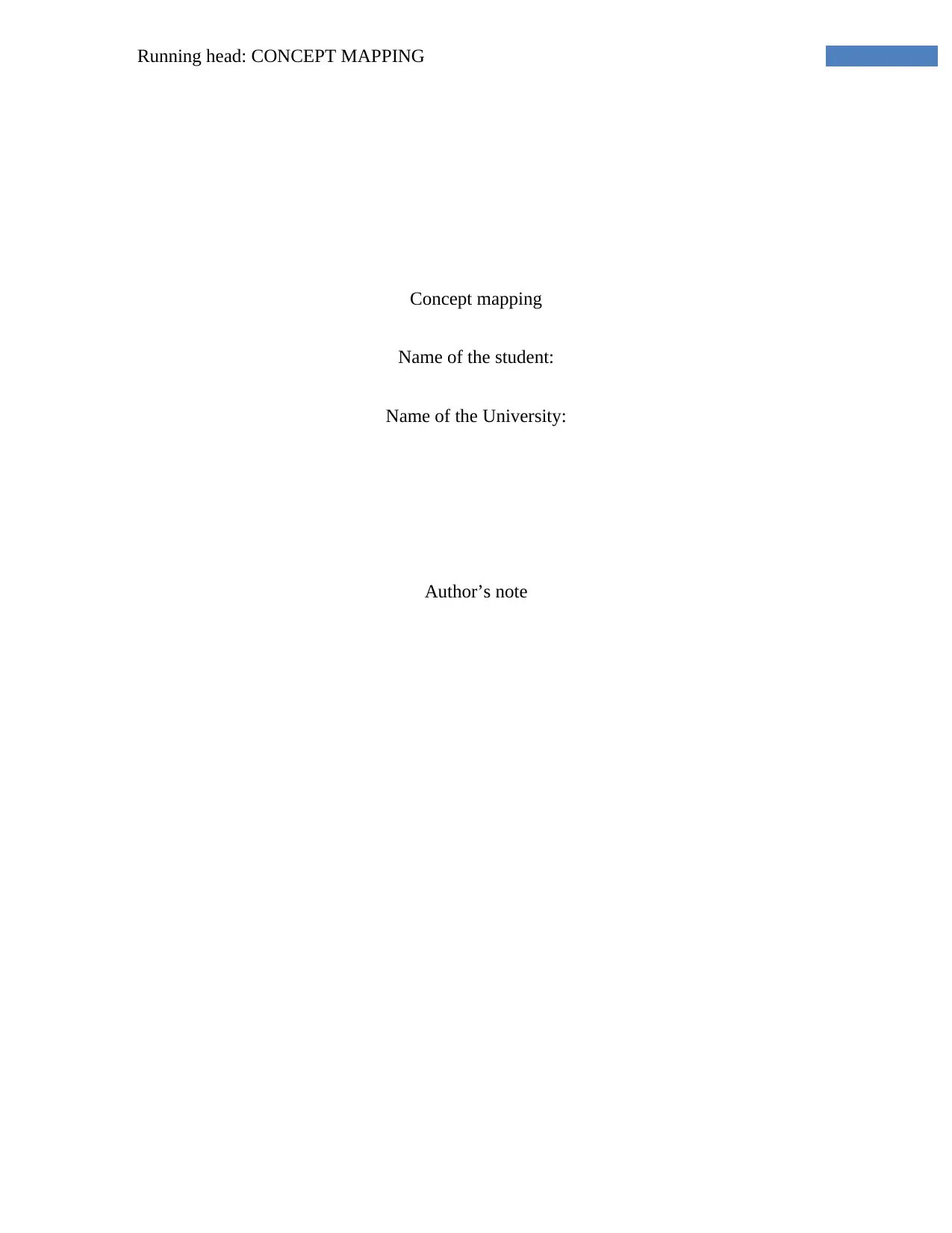
Running head: CONCEPT MAPPING
Concept mapping
Name of the student:
Name of the University:
Author’s note
Concept mapping
Name of the student:
Name of the University:
Author’s note
Paraphrase This Document
Need a fresh take? Get an instant paraphrase of this document with our AI Paraphraser
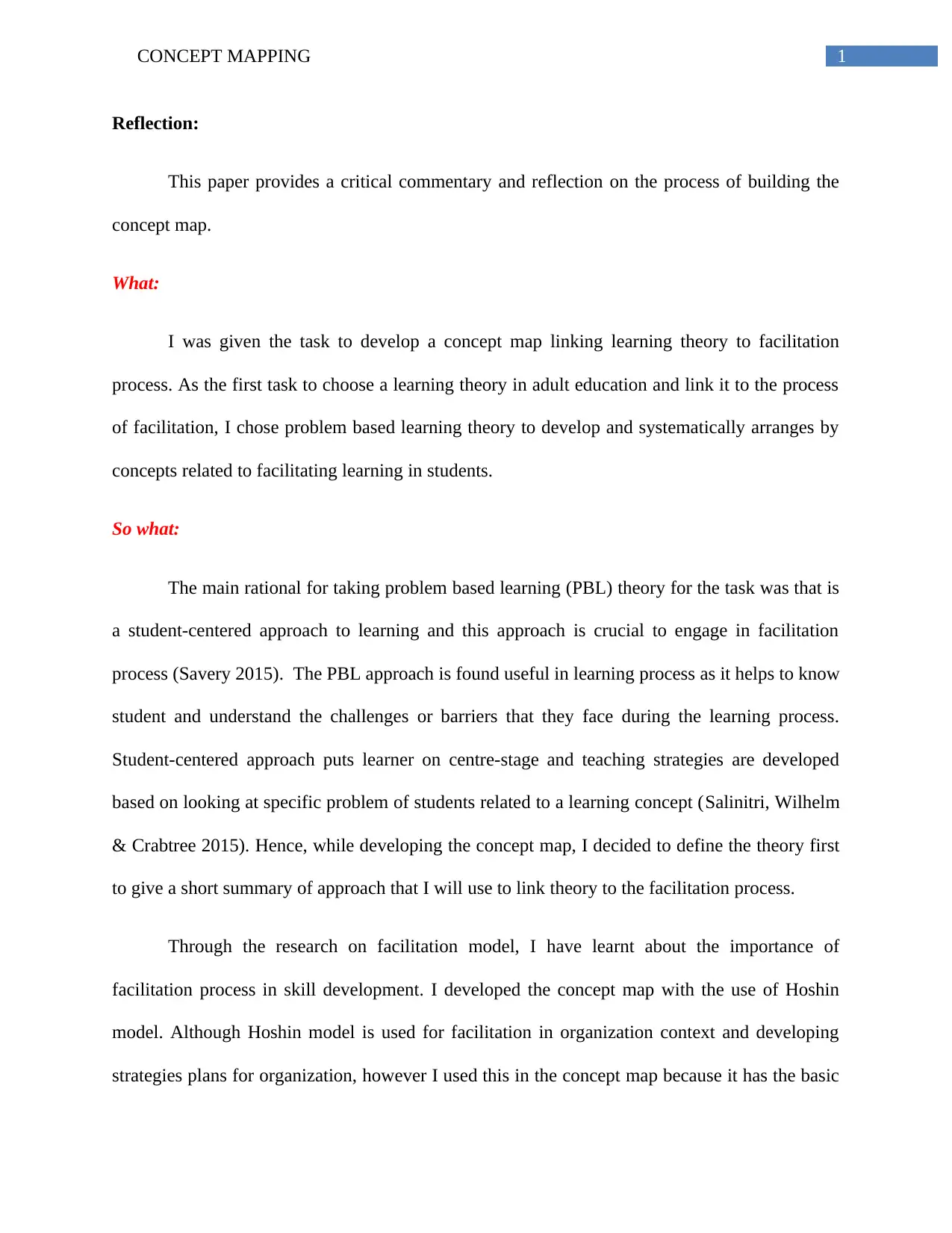
1CONCEPT MAPPING
Reflection:
This paper provides a critical commentary and reflection on the process of building the
concept map.
What:
I was given the task to develop a concept map linking learning theory to facilitation
process. As the first task to choose a learning theory in adult education and link it to the process
of facilitation, I chose problem based learning theory to develop and systematically arranges by
concepts related to facilitating learning in students.
So what:
The main rational for taking problem based learning (PBL) theory for the task was that is
a student-centered approach to learning and this approach is crucial to engage in facilitation
process (Savery 2015). The PBL approach is found useful in learning process as it helps to know
student and understand the challenges or barriers that they face during the learning process.
Student-centered approach puts learner on centre-stage and teaching strategies are developed
based on looking at specific problem of students related to a learning concept (Salinitri, Wilhelm
& Crabtree 2015). Hence, while developing the concept map, I decided to define the theory first
to give a short summary of approach that I will use to link theory to the facilitation process.
Through the research on facilitation model, I have learnt about the importance of
facilitation process in skill development. I developed the concept map with the use of Hoshin
model. Although Hoshin model is used for facilitation in organization context and developing
strategies plans for organization, however I used this in the concept map because it has the basic
Reflection:
This paper provides a critical commentary and reflection on the process of building the
concept map.
What:
I was given the task to develop a concept map linking learning theory to facilitation
process. As the first task to choose a learning theory in adult education and link it to the process
of facilitation, I chose problem based learning theory to develop and systematically arranges by
concepts related to facilitating learning in students.
So what:
The main rational for taking problem based learning (PBL) theory for the task was that is
a student-centered approach to learning and this approach is crucial to engage in facilitation
process (Savery 2015). The PBL approach is found useful in learning process as it helps to know
student and understand the challenges or barriers that they face during the learning process.
Student-centered approach puts learner on centre-stage and teaching strategies are developed
based on looking at specific problem of students related to a learning concept (Salinitri, Wilhelm
& Crabtree 2015). Hence, while developing the concept map, I decided to define the theory first
to give a short summary of approach that I will use to link theory to the facilitation process.
Through the research on facilitation model, I have learnt about the importance of
facilitation process in skill development. I developed the concept map with the use of Hoshin
model. Although Hoshin model is used for facilitation in organization context and developing
strategies plans for organization, however I used this in the concept map because it has the basic
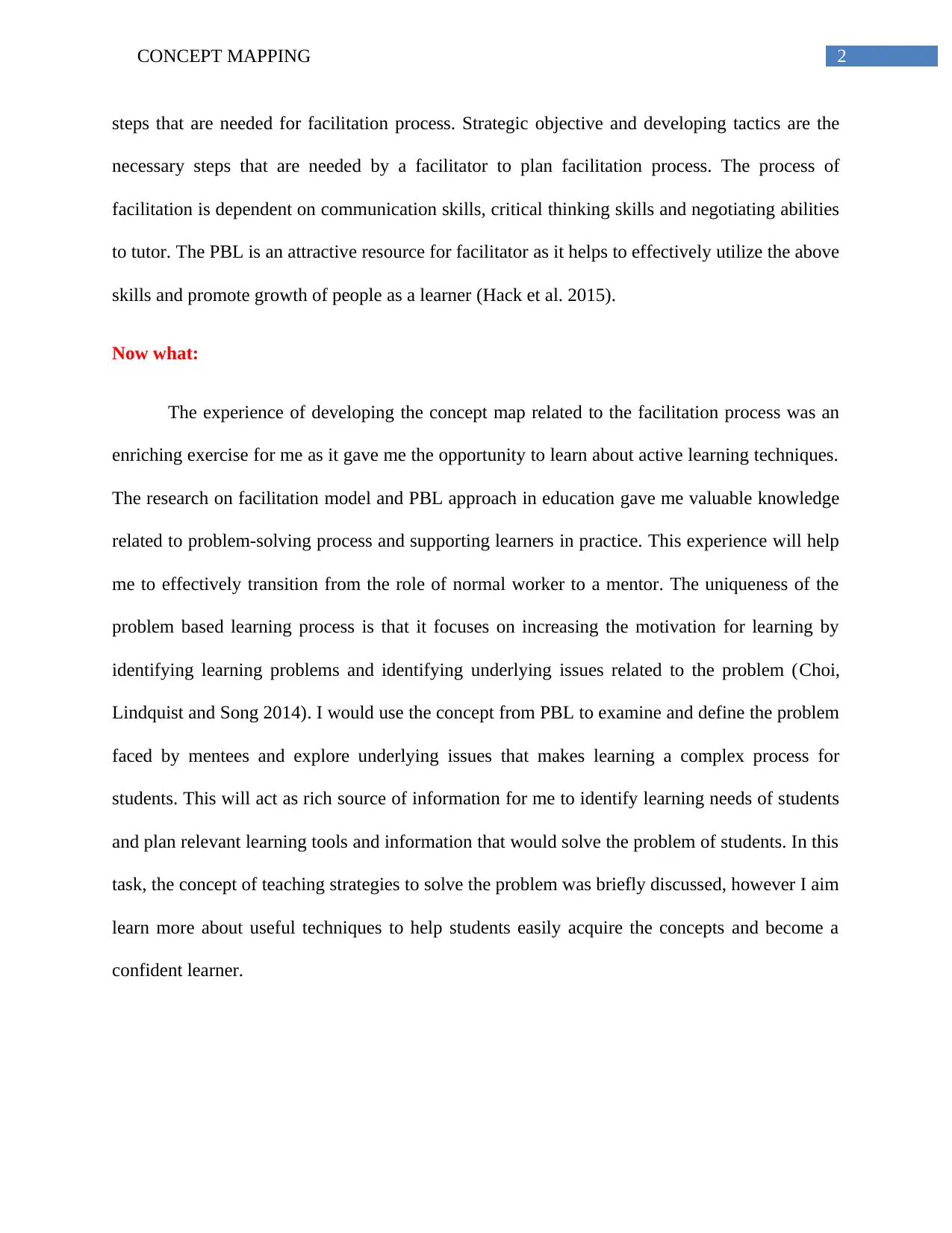
2CONCEPT MAPPING
steps that are needed for facilitation process. Strategic objective and developing tactics are the
necessary steps that are needed by a facilitator to plan facilitation process. The process of
facilitation is dependent on communication skills, critical thinking skills and negotiating abilities
to tutor. The PBL is an attractive resource for facilitator as it helps to effectively utilize the above
skills and promote growth of people as a learner (Hack et al. 2015).
Now what:
The experience of developing the concept map related to the facilitation process was an
enriching exercise for me as it gave me the opportunity to learn about active learning techniques.
The research on facilitation model and PBL approach in education gave me valuable knowledge
related to problem-solving process and supporting learners in practice. This experience will help
me to effectively transition from the role of normal worker to a mentor. The uniqueness of the
problem based learning process is that it focuses on increasing the motivation for learning by
identifying learning problems and identifying underlying issues related to the problem (Choi,
Lindquist and Song 2014). I would use the concept from PBL to examine and define the problem
faced by mentees and explore underlying issues that makes learning a complex process for
students. This will act as rich source of information for me to identify learning needs of students
and plan relevant learning tools and information that would solve the problem of students. In this
task, the concept of teaching strategies to solve the problem was briefly discussed, however I aim
learn more about useful techniques to help students easily acquire the concepts and become a
confident learner.
steps that are needed for facilitation process. Strategic objective and developing tactics are the
necessary steps that are needed by a facilitator to plan facilitation process. The process of
facilitation is dependent on communication skills, critical thinking skills and negotiating abilities
to tutor. The PBL is an attractive resource for facilitator as it helps to effectively utilize the above
skills and promote growth of people as a learner (Hack et al. 2015).
Now what:
The experience of developing the concept map related to the facilitation process was an
enriching exercise for me as it gave me the opportunity to learn about active learning techniques.
The research on facilitation model and PBL approach in education gave me valuable knowledge
related to problem-solving process and supporting learners in practice. This experience will help
me to effectively transition from the role of normal worker to a mentor. The uniqueness of the
problem based learning process is that it focuses on increasing the motivation for learning by
identifying learning problems and identifying underlying issues related to the problem (Choi,
Lindquist and Song 2014). I would use the concept from PBL to examine and define the problem
faced by mentees and explore underlying issues that makes learning a complex process for
students. This will act as rich source of information for me to identify learning needs of students
and plan relevant learning tools and information that would solve the problem of students. In this
task, the concept of teaching strategies to solve the problem was briefly discussed, however I aim
learn more about useful techniques to help students easily acquire the concepts and become a
confident learner.
⊘ This is a preview!⊘
Do you want full access?
Subscribe today to unlock all pages.

Trusted by 1+ million students worldwide
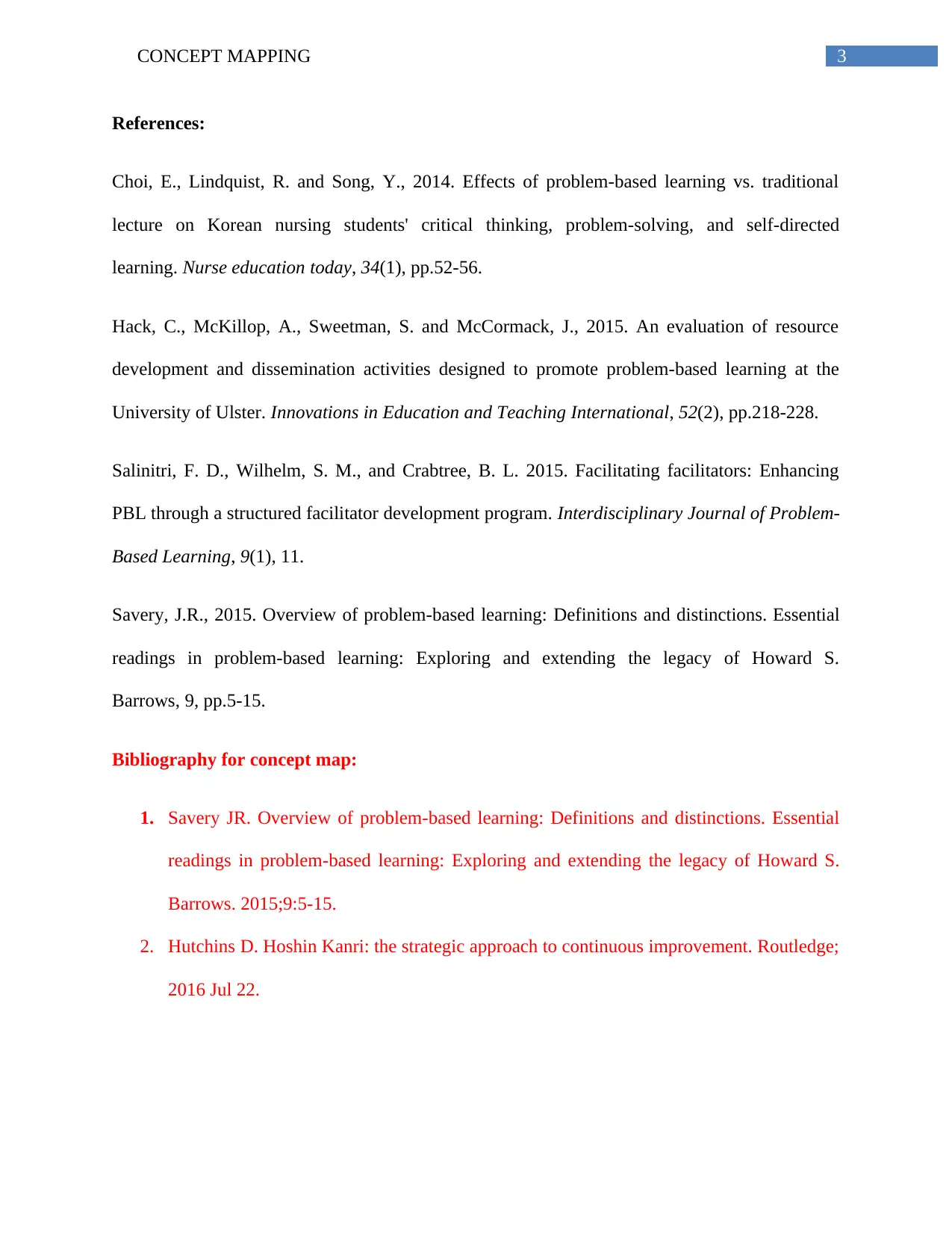
3CONCEPT MAPPING
References:
Choi, E., Lindquist, R. and Song, Y., 2014. Effects of problem-based learning vs. traditional
lecture on Korean nursing students' critical thinking, problem-solving, and self-directed
learning. Nurse education today, 34(1), pp.52-56.
Hack, C., McKillop, A., Sweetman, S. and McCormack, J., 2015. An evaluation of resource
development and dissemination activities designed to promote problem-based learning at the
University of Ulster. Innovations in Education and Teaching International, 52(2), pp.218-228.
Salinitri, F. D., Wilhelm, S. M., and Crabtree, B. L. 2015. Facilitating facilitators: Enhancing
PBL through a structured facilitator development program. Interdisciplinary Journal of Problem-
Based Learning, 9(1), 11.
Savery, J.R., 2015. Overview of problem-based learning: Definitions and distinctions. Essential
readings in problem-based learning: Exploring and extending the legacy of Howard S.
Barrows, 9, pp.5-15.
Bibliography for concept map:
1. Savery JR. Overview of problem-based learning: Definitions and distinctions. Essential
readings in problem-based learning: Exploring and extending the legacy of Howard S.
Barrows. 2015;9:5-15.
2. Hutchins D. Hoshin Kanri: the strategic approach to continuous improvement. Routledge;
2016 Jul 22.
References:
Choi, E., Lindquist, R. and Song, Y., 2014. Effects of problem-based learning vs. traditional
lecture on Korean nursing students' critical thinking, problem-solving, and self-directed
learning. Nurse education today, 34(1), pp.52-56.
Hack, C., McKillop, A., Sweetman, S. and McCormack, J., 2015. An evaluation of resource
development and dissemination activities designed to promote problem-based learning at the
University of Ulster. Innovations in Education and Teaching International, 52(2), pp.218-228.
Salinitri, F. D., Wilhelm, S. M., and Crabtree, B. L. 2015. Facilitating facilitators: Enhancing
PBL through a structured facilitator development program. Interdisciplinary Journal of Problem-
Based Learning, 9(1), 11.
Savery, J.R., 2015. Overview of problem-based learning: Definitions and distinctions. Essential
readings in problem-based learning: Exploring and extending the legacy of Howard S.
Barrows, 9, pp.5-15.
Bibliography for concept map:
1. Savery JR. Overview of problem-based learning: Definitions and distinctions. Essential
readings in problem-based learning: Exploring and extending the legacy of Howard S.
Barrows. 2015;9:5-15.
2. Hutchins D. Hoshin Kanri: the strategic approach to continuous improvement. Routledge;
2016 Jul 22.
Paraphrase This Document
Need a fresh take? Get an instant paraphrase of this document with our AI Paraphraser
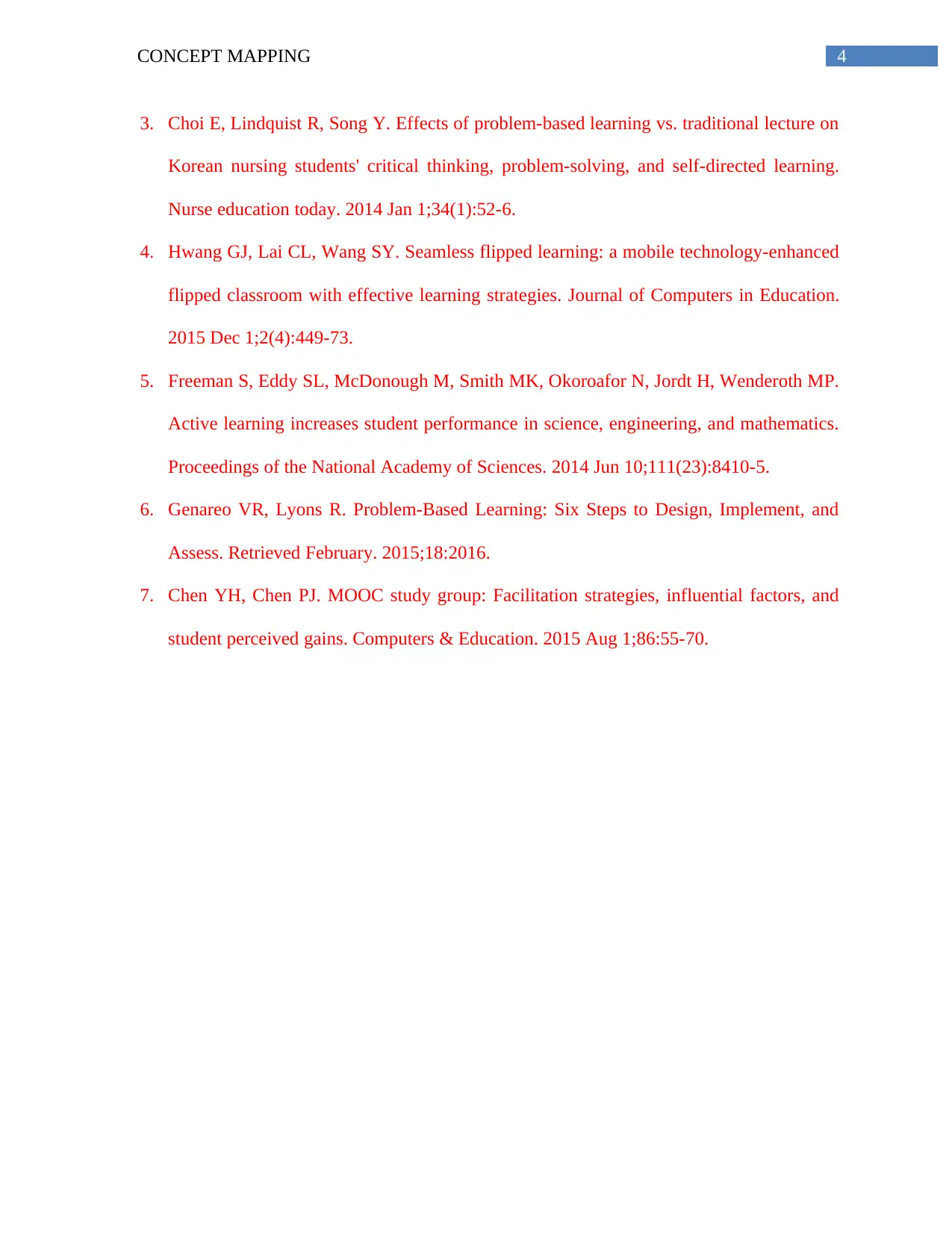
4CONCEPT MAPPING
3. Choi E, Lindquist R, Song Y. Effects of problem-based learning vs. traditional lecture on
Korean nursing students' critical thinking, problem-solving, and self-directed learning.
Nurse education today. 2014 Jan 1;34(1):52-6.
4. Hwang GJ, Lai CL, Wang SY. Seamless flipped learning: a mobile technology-enhanced
flipped classroom with effective learning strategies. Journal of Computers in Education.
2015 Dec 1;2(4):449-73.
5. Freeman S, Eddy SL, McDonough M, Smith MK, Okoroafor N, Jordt H, Wenderoth MP.
Active learning increases student performance in science, engineering, and mathematics.
Proceedings of the National Academy of Sciences. 2014 Jun 10;111(23):8410-5.
6. Genareo VR, Lyons R. Problem-Based Learning: Six Steps to Design, Implement, and
Assess. Retrieved February. 2015;18:2016.
7. Chen YH, Chen PJ. MOOC study group: Facilitation strategies, influential factors, and
student perceived gains. Computers & Education. 2015 Aug 1;86:55-70.
3. Choi E, Lindquist R, Song Y. Effects of problem-based learning vs. traditional lecture on
Korean nursing students' critical thinking, problem-solving, and self-directed learning.
Nurse education today. 2014 Jan 1;34(1):52-6.
4. Hwang GJ, Lai CL, Wang SY. Seamless flipped learning: a mobile technology-enhanced
flipped classroom with effective learning strategies. Journal of Computers in Education.
2015 Dec 1;2(4):449-73.
5. Freeman S, Eddy SL, McDonough M, Smith MK, Okoroafor N, Jordt H, Wenderoth MP.
Active learning increases student performance in science, engineering, and mathematics.
Proceedings of the National Academy of Sciences. 2014 Jun 10;111(23):8410-5.
6. Genareo VR, Lyons R. Problem-Based Learning: Six Steps to Design, Implement, and
Assess. Retrieved February. 2015;18:2016.
7. Chen YH, Chen PJ. MOOC study group: Facilitation strategies, influential factors, and
student perceived gains. Computers & Education. 2015 Aug 1;86:55-70.
1 out of 5
Related Documents
Your All-in-One AI-Powered Toolkit for Academic Success.
+13062052269
info@desklib.com
Available 24*7 on WhatsApp / Email
![[object Object]](/_next/static/media/star-bottom.7253800d.svg)
Unlock your academic potential
Copyright © 2020–2025 A2Z Services. All Rights Reserved. Developed and managed by ZUCOL.





